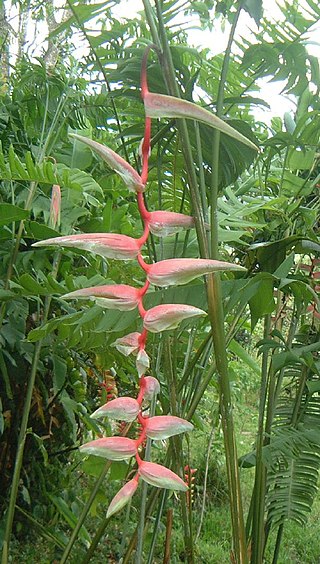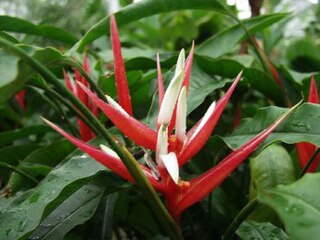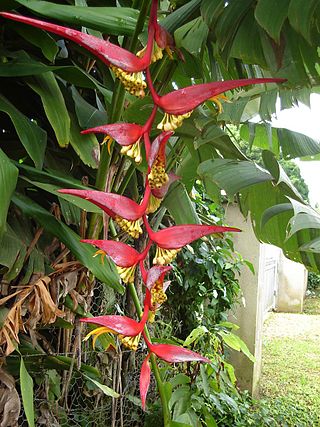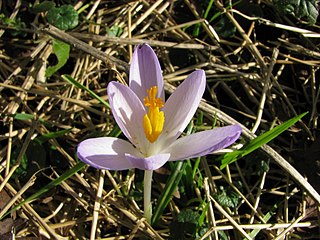
The Zingiberales are flowering plants forming one of four orders in the commelinids clade of monocots, together with its sister order, Commelinales. The order includes 68 genera and 2,600 species. Zingiberales are a unique though morphologically diverse order that has been widely recognised as such over a long period of time. They are usually large herbaceous plants with rhizomatous root systems and lacking an aerial stem except when flowering. Flowers are usually large and showy, and the stamens are often modified (staminodes) to also form colourful petal-like structures that attract pollinators.

Heliconia is a genus of flowering plants in the monotypic family Heliconiaceae. Most of the 194 known species are native to the tropical Americas, but a few are indigenous to certain islands of the western Pacific and Maluku in Indonesia. Many species of Heliconia are found in the tropical forests of these regions. Most species are listed as either vulnerable or data deficient by the IUCN Red List of threatened species. Several species are widely cultivated as ornamentals, and a few are naturalized in Florida, Gambia, and Thailand.

Calathea is a genus of flowering plants belonging to the family Marantaceae. They are commonly called calatheas or prayer plants. About 200 species formerly assigned to Calathea are now in the genus Goeppertia. Calathea currently contains around 60 species. Native to the tropical Americas, many of the species are popular as pot plants due to their decorative leaves and, in some species, colorful inflorescences. The young leaves and bracts can retain pools of water called phytotelmata, that provide habitat for many invertebrates.

Heliconia chartacea is a species of Heliconia native to tropical South America.

Heliconia acuminata is a species of plant in the family Heliconiaceae. It is an erect herb, typically growing 1.6 m tall, native to the South American countries of Brazil, French Guiana, Guyana, Suriname, Venezuela, Colombia, Bolivia and Peru. It is also grown as an ornamental plant in other regions.

Heliconia angusta Vell., of family Heliconiaceae is an erect herb typically growing 0.70 m tall, native to Brazil.

Heliconia collinsiana (platanillo) of family Heliconiaceae is an erect herb typically growing 10–15 feet (3.0–4.6 m) tall, native to Guatemala, Honduras, El Salvador, Nicaragua and southern Mexico.

Phytotelma is a small water-filled cavity in a terrestrial plant. The water accumulated within these plants may serve as the habitat for associated fauna and flora.
Polyscias crassa is a species of plant in the family Araliaceae. It is endemic to Seychelles. It is threatened by habitat loss.
Heliconia excelsa is a species of plant in the family Heliconiaceae. It is endemic to Ecuador. Its natural habitat is subtropical or tropical moist lowland forest.
Heliconia × flabellata is a species of plant in the family Heliconiaceae. It is endemic to Ecuador. Its natural habitat is subtropical or tropical moist lowland forest. It is apparently a hybrid, H. episcopalis × H. rostrata.
Heliconia obscura is a species of plant in the family Heliconiaceae. It is native to Ecuador and Peru. Its natural habitats are subtropical or tropical moist lowland forests and subtropical or tropical moist montane forests.

Renealmia is a plant genus in the family Zingiberaceae. Its members are native to tropical Africa and tropical America. In Peru, fruits and tubers are sources of indigenous dyes. and indigenous medical treatments for leishmania and malaria In Colombia, it is used to treat snakebite. Bracts and leaves can serve as phytotelmata, retaining small quantities of water that offer habitat for other organisms.

Ismene, or Peruvian daffodil, is a genus of South American plants in the Amaryllis family. The species are native to Peru and Ecuador and widely cultivated elsewhere as ornamentals because of their large, showy flowers.

Crocus tommasinianus, the woodland crocus, early crocus, or Tommasini's crocus, is a species of flowering plant in the family Iridaceae. It is named after the botanist Muzio G. Spirito de Tommasini (1794-1879). It is native to Bulgaria, Hungary, Albania, and the former Yugoslavia. It is often referred to as the early or snow crocus, but these terms are shared with several other species, although C. tommasinianus is amongst the first to bloom. Multiple plants are often called tommies in the horticultural trade.

Heliconia burleana is a species of plant in the family Heliconiaceae. It is native to Ecuador, Colombia and Peru. Its natural habitat is subtropical or tropical moist montane forest.
Heliconia angelica is a species of plant in the family Heliconiaceae. It is endemic to Ecuador. Its natural habitat is subtropical or tropical moist montane forest. The plant was named "angelica" because of the resemblance of the flower bracts to the wings of angels.

Heliconia aemygdiana is a species of flowering plant in the family Heliconiaceae. It is a rhizomatous geophyte found in tropical South America. It has a cucumber-like aroma.

Costus productus, known as orange tulip ginger, dwarf orange ginger, or green mountain spiral flag, is a species of plant in the Costaceae family. Costus productus is native to South Colombia and Peru.






